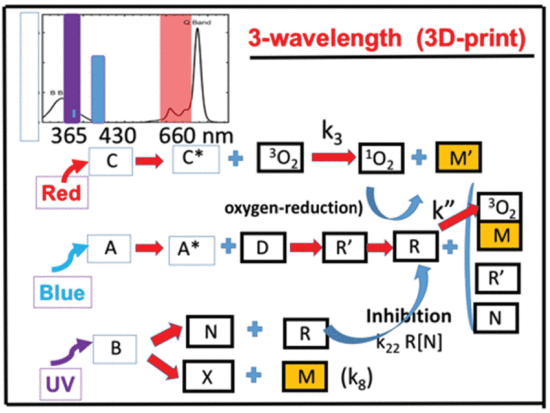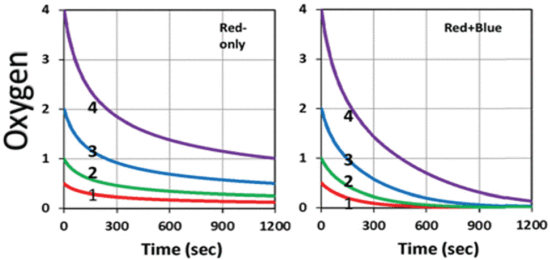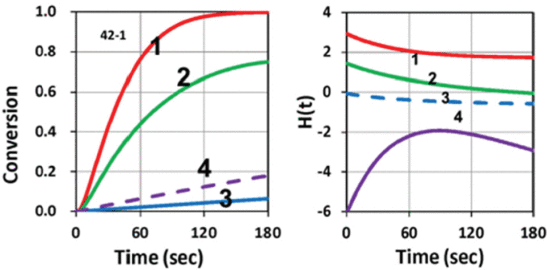Taiwanese scientists are researching ways to overcome obstacles in photolithography, detailing their findings in the recently published paper, ‘3-Wavelength (UV, Blue, Red) Controlled Photo-Confinement for 3D-Printing: Kinetics and Modeling.’
Historically, photolithography has been limited in prototyping to fabrication of thin layers of material created via single wavelength light. To expand such techniques, the researchers explored two-color (UV and blue light), direct-write photolithography.
Currently, photopolymerization confinement (PC) is a common technique for continuous printing in additive manufacturing, offering a way to fabricate structures at high linear velocities, along with using only a single exposure.
Streamlined 3-Wavelength PC requires the following:
- Photoinhibition light (UV)
- Numerous, compatible monomers and co-initiators
- Photoinhibition of free-radical chain-growth
- Spatially confined, formulated resins
- Elimination of inhibitor species in the dark or after UV exposure
- Large polymerization inhibition depth adjacent to the projection window
- Continuous part production

Schematics of photochemical pathways of a 3-wavelength photopolymerization, in which crosslinkers are formed via three pathways: the photoinitiator A (under a blue light), B (under a UV light), and oxygen-mediated C (under a red light). The initiation radicals R, [1O2] and [X] initiate the monomer [M] polymerization; whereas the inhibition radical [N] reduces the active radical R. Also shown is the co-initiator (D) which reacts with the triplet state of A (A*) forming an intermediate radical (R’) and a reactive radical (R), initiating crosslinkers; terminations may be resulted by the interaction among R’, R and [N]. The blue-light conversion could be enhanced by pre-irradiation of the red-light which reduces the oxygen-inhibition effect; whereas it could be reduced by the inhibitor [N], as a switch-off mechanism. Right hand side shows the couplings among R and (R’, N, M, 3O2), in which the oxygen inhibition is governed by the rate constant, k”.
“In dual-wavelength systems, the IT may be reduced by decreasing irradiation intensity and thus increase the print speeds as polymerization proceeds closer to the projection window,” stated the researchers. “For a given resin composition, the IT depends on the ratio of inhibitor to initiator absorbance, quantum yield of the radicals, reaction rates among the radicals and monomers, initiator, co-initiator and inhibitor, and the light intensity and dose (or exposure time).”
If the light is varied by pixel, the system can also complete topographical patterning on the surface with a single exposure layer. For a perpendicular scheme, photopolymerizations have been noted as confining ‘in depth the regional polymerized resin,’ with blue and UV lights causing respective polymerization initiation and inhibition.

Oxygen profiles under the irradiation of red-light only (left); blue and red light (right); but in the absence of UV-light (or B2=0 ), for various initial oxygen concentration of [O2]0=(0.5,1.0, 2.0, 4.0)%, for curve (1,2,3,4); and [A]0=[B]0 = 1%; B1=B3=0.05 (1/s/%); and rate constants (k,k’,k”,kT)= (8,1, 0.1,0.5) ((1/s). profiles of blue-light (without UV-light) for (left Figure) C10= (0.05, 0.1, 0.2, 0.4) %, for curve (1,2,3,4), for fixed b1=0.1 ; and (right Figure) b1=(0.015,0.05,0.15,0.5) , for fixed C10=0.2 %; for C30=0.5 %, [M]0 = 0.2%, k’ =1.0, kT=0.5 , k57= (k5/k7)=k68= (k6/k8)= k” = 35 (1/s).
A reverse feature was noted when [B] was higher than the transition value—leading to higher conversion as predicted by the research team’s formula:
“This is one of the new findings of this modeling study, which, however, requires further experimental justification,” stated the authors.

Conversion profiles (left) and H-function (right), under the irradiation of 2-light (blue and UV), without oxygen ([O2]0.=0) or the red-light (B3=0 ), for various initial concentration of [B]0 = (0, 0.5, 1.0, 3.0)1%, for curves (1,2,3,4); and for (B1, B2)= (0.05, 0.003), and [A]0 = 1%.
“Higher oxygen concentration leads to a lower conversion, which could be enhanced by reducing the S-inhibition via a red or blue-light pre-irradiation,” concluded the researchers. “The strategy for an efficient PC could be achieved by tailoring the two competing factors, N-inhibition and S-inhibition, independently via the steps of: (i) red-light pre-irradiation for minimal S-inhibition (oxygen-inhibition); and (ii) followed by a combined irradiation of UV and blue light, under the criterion for efficient PC to achieve reduced confinement depth, and high print speed.”
What do you think of this news? Let us know your thoughts! Join the discussion of this and other 3D printing topics at 3DPrintBoard.com.
[Source / Images: ‘3-Wavelength (UV, Blue, Red) Controlled Photo-Confinement for 3D-Printing: Kinetics and Modeling’]Subscribe to Our Email Newsletter
Stay up-to-date on all the latest news from the 3D printing industry and receive information and offers from third party vendors.
Print Services
Upload your 3D Models and get them printed quickly and efficiently.
You May Also Like
The Dental Additive Manufacturing Market Could Nearly Double by 2033, According to AM Research
According to an AM Research report from 2024, the medical device industry, specifically in dentistry, prosthetics, and audiology, is expected to see significant growth as these segments continue to benefit from...
Heating Up: 3D Systems’ Scott Green Discusses 3D Printing’s Potential in the Data Center Industry
The relentless rise of NVIDIA, the steadily increasing pledges of major private and public investments in national infrastructure projects around the world, and the general cultural obsession with AI have...
AM Research Webinar Explores Continuum’s Sustainable Metal Additive Manufacturing Powders
Metal additive manufacturing (AM) powder supplier Continuum Powders is working to develop solutions that empower industries to reduce waste and optimize their resources. An independent life cycle assessment (LCA) of...
3D Printed Footwear Startup Koobz Lands $7.2M in Seed Round
California-based Koobz is focused on reshoring the U.S. footwear supply chain with advanced manufacturing processes, including 3D printing. The startup just announced that it has added $6 million to its...
































